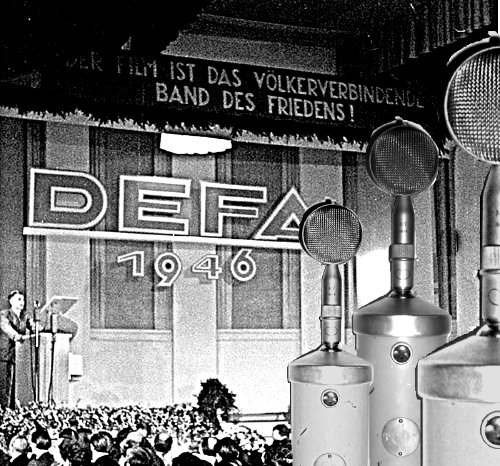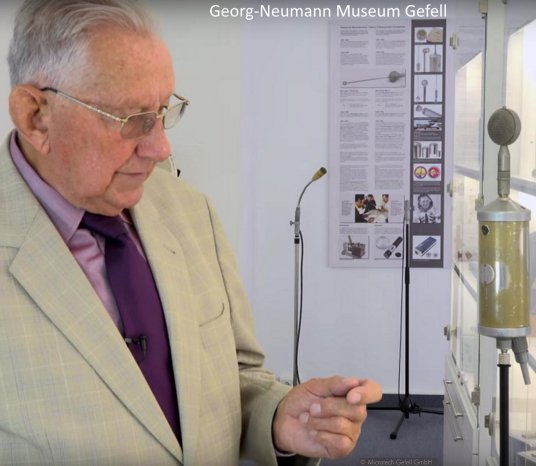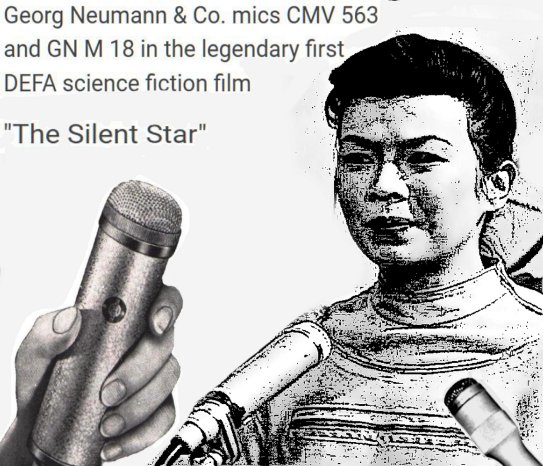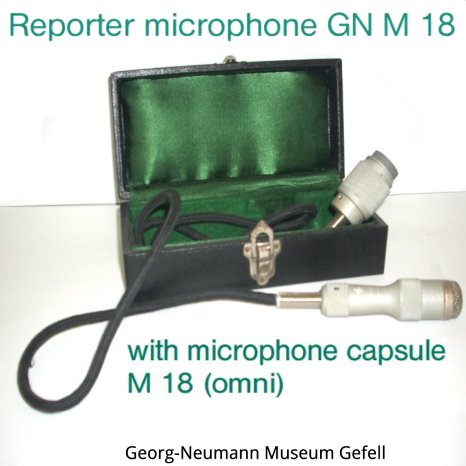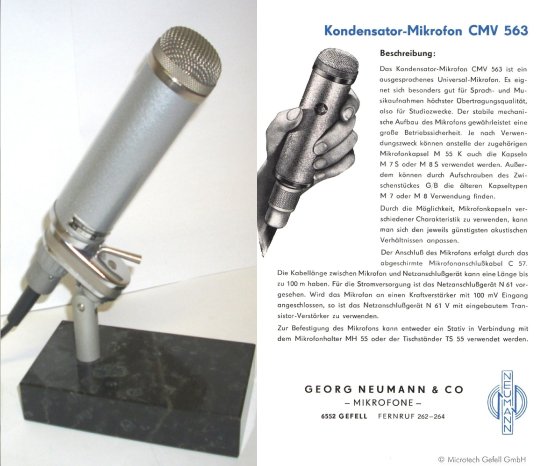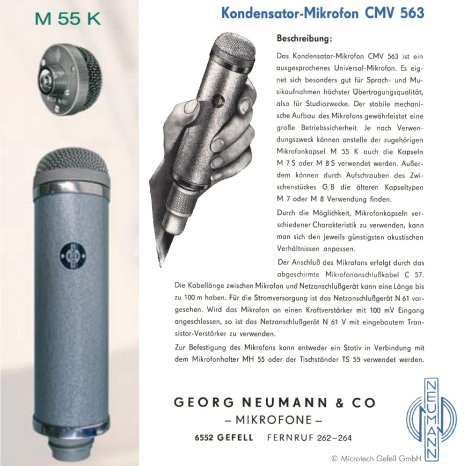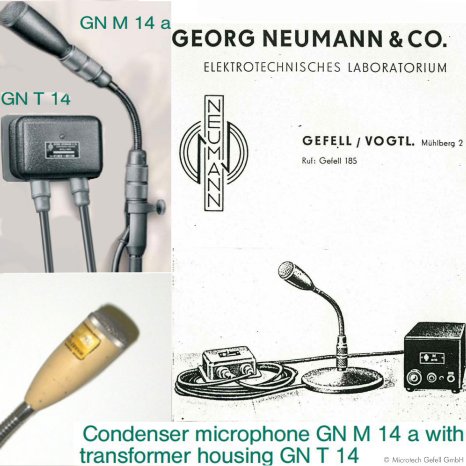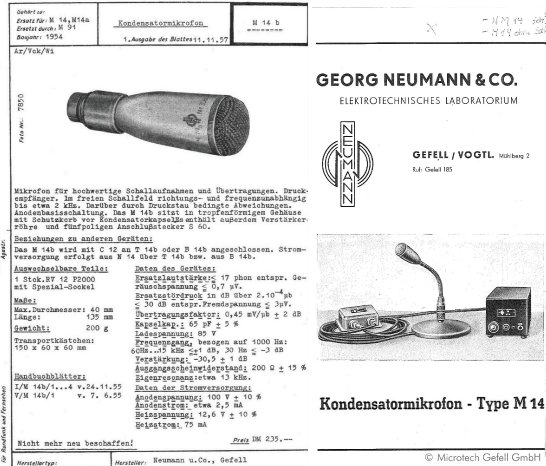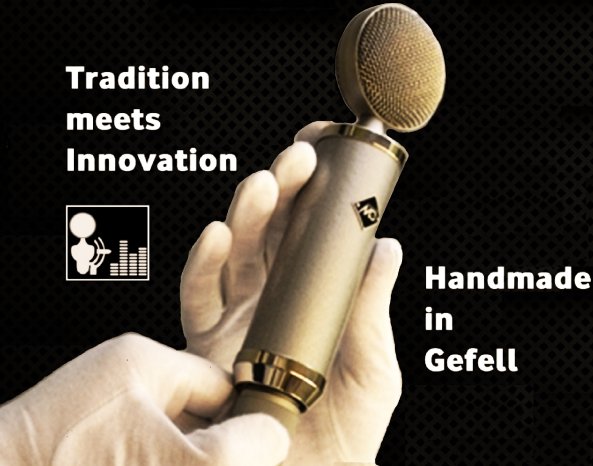On 17 May 1946, Deutsche Film-AG (DEFA) was founded in Potsdam-Babelsberg as a Soviet-German joint stock company.
After the founding of the German Democratic Republic/GDR on 7 October 1949, the film studios, workshops and sound studios gradually passed into German hands.
In 1953, the DEFA studios for feature films, children's films, popular science films, newsreels and documentaries, film dubbing and the DEFA studio for animated films (1955) were established.
The former Ufa studios, known for film classics of the 1920s such as Dr. Mabuse, The Gambler, Nosferatu - A Symphony of Horror, Fritz Lang's Metropolis or The Blue Angel with Marlene Dietrich and Emil Jannings, were also used.
Widely used by UfA and later DEFA was the first industrially manufactured condenser microphone - the CMV 3, also called the "Neumann bottle", distributed by Telefunken, a subsidiary of AEG.
The microphones of the company Georg Neumann & Co. founded in Berlin in 1928, relocated to Gefell in 1943 as a second company founded by Georg Neumann due to the war and remaining in Gefell as Georg Neumann & Co. already played an important role in Ufa film, music and other productions.
Neumann condenser microphones in low-frequency tube circuitry represented a revolution in microphone construction and were far superior to all microphones available up to that time.
In contrast to their carbon mic predecessors, the condenser microphones were characterised by significantly improved acoustic properties.
The "Neumann bottle" was comparatively low-noise and reproduced almost the entire range of human hearing, which was essential for studio and recording.
A further advance was the development of the legendary Neumann - M 7 capsule with PVC diaphragm and its market launch in 1932. The M 7, which is still handmade in Gefell today, made it possible to equip the CMV 3 with interchangeable capsules of different polar patterns.
Neumann microphones were often used by the National Socialists for propaganda productions, for example as speaking microphones in news reports for the UFA cinema newsreel or in sound studios for cinema films. Box-office hits, revue and musical films of the 1930s and 40s with stars such as Marlene Dietrich, Lilian Harvey, Zarah Leander, Marika Rökk, Hans Albers or Johannes Heesters were accompanied by the UFA orchestra and recorded by "Neumann bottles".
Whether for radio, film, concert, revue or lectern, the CMV series developed into the audio gold standard in the microphone field.
So it is no coincidence that DEFA also used Neumann microphones from the very beginning.
„Neumann bottles“ can already be seen at the lectern during the DEFA founding ceremony and in legendary post-war anti-fascist productions such as the Bruno Apitz novel adaptation "Nackt unter Wölfen" (ARD remake 2015 /UFA Fiction GmbH/ Babelsberg).
Georg Neumann & Co. microphones from Gefell were also used in other DEFA productions, so, e.g., in the legendary first DEFA science fiction film "The Silent Star" („Der schweigende Stern“) from 1960. The film was an international success with audiences not only in the GDR. It was released in September 1960 under the title "Raumschiff Venus antwortet nicht" ("Spaceship Venus doesn't answer") by Constantin Film in cinemas in the Federal Republic of Germany. A shortened version was released in the USA and Great Britain under the title "First Spaceship on Venus".
The main theme of the Anti-war film, in view of the Cold War and the atomic bomb tests in the USA and the Soviet Union, is the warning of a nuclear catastrophe.
The Georg Neumann & Co. microphones GN M 18 and the vintage microphone CMV 563, which is still in demand today, can be seen in the film as speaker and reporter microphones in the interview scenes.
The history of DEFA structures and Gefell
In connection with the reconstruction of the East German broadcasting and film institutions, in
in the 1950s, the production of well-known microphone types was continued or newly developed.
Products included, for example, the CMV 563 tube microphone preamplifier with the microphone capsules M 55 K (omnidirectional), M 7 (cardioid), M 8 (figure-eight) and M 9 (omnidirectional) as well as, with a short shaft, the M 7 S, M 8 S and M 9 S or the UM 57 tube condenser microphone.
Whether as film props or for recording purposes, microphones made by Georg Neumann & Co, later, after nationalisation as VEB Mikrofontechnik Gefell with the RFT logo, supported a large number of DEFA productions.
In the 2009 publication by Günter Jordan entitled "Film in der DDR. Daten - Fakten -Strukturen" (Data - Facts - Structures), for example, under the heading "Geräteproduktion außerhalb DEFA" (Equipment production outside DEFA), one finds as delivery partner both the "Georg Neumann & Co. KG (1943/1947)" as well as the "VEB Mikrofontechnik Gefell (1972)" for the field of microphones (source: Filmmuseum Potsdam / online edition of the elaborate basic research).
For example, lightweight microphones from VEB Mikrofontechnik Neumann/Gefell were an integral part of the mobile technical equipment of DEFA sound recording crews in the 1970s.
Microphone technology from Gefell can also be found in the DEFA sound film museum in Studio Babelsberg.
On display are several versions of the CMV3, its successor models and other Neumann/Gefell microphones, such as a so-called "Thälmann microphone".
The name comes from the fact that M 14 S pairs of microphones were used for stereo sound recordings of the DEFA feature film "Ernst Thälmann - Führer seiner Klasse" in 1954/55.
The money for the elaborate development came from the GDR Ministry of Culture. The hope was to achieve a particularly intense propagandistic effect from the upcoming filming of the second part of the biography, Ernst Thälmann (communist German workers' leader) using spatial sound.
Handmade in Gefell for film, TV and broadcast - yesterday and today
Microphones from Gefell are not only found in museums today. True to the motto "Tradition meets Innovation", Microtech Gefell continues to meet the high demands placed on microphone technology for film, radio and television.
Today, Gefell microphones are in use worldwide in film-,TV- and broadcast production as well as in accompanying scientific media research and education, e.g. at the University of Film and Television "Konrad Wolf" (Potsdam-Babelsberg), at the media centres of the University of Erfurt, the Colombian elite university Universidad de la Sabana, the Communication University of China as well as or in film and television studios such as Studio Berlin Adlershof or North Film Studios.
This also applies to many post-production studios such as Studiopolis (Studio City, Los Angeles) or the JAT Studio of James Arnold Taylor, one of Hollywood's most versatile voice actors, known worldwide as an established event organiser for Disney, LucasFilm, REEDPop, SquareEnix and the USO.
Conclusion
Georg Neumann & Co, Elektrotechnisches Laboratorium Gefell i.V., RFT Mikrofontechnik Gefell and, last but not least, Microtech Gefell GmbH - these different names for one and the same company bear witness to social radical changes that the company has had to survive in its more than 90-year history. However, nothing has changed in the company's claim to supply the best possible microphones for Film, TV and Broadcast, in keeping with the tradition of its founder Georg Neumann.
